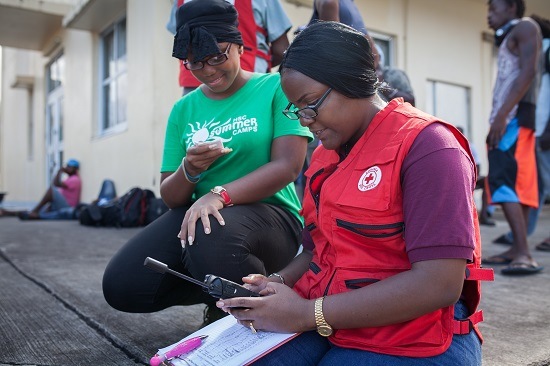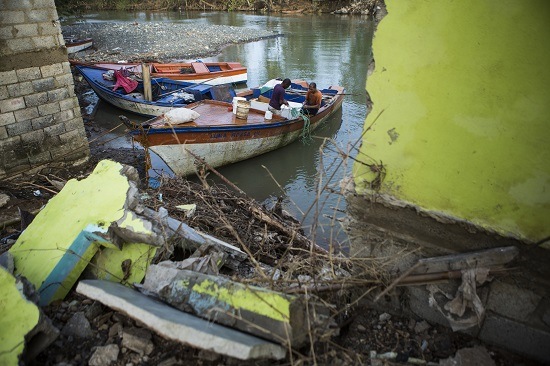
The Dominica Red Cross, supported by IFRC, provides people with the chance to call loved ones using satellite phones. “In the first two days, we have successfully connected over 100 families,” says Susan Schaefer, Restoring Family Links delegate in Dominica. Photo: Nina Svahn / Finnish Red Cross
More than 10 countries and territories were directly affected as Hurricane Irma ravaged the Caribbean and later the coastal states in the U.S. The International Federation of Red Cross Red Crescent Societies (IFRC) reports various levels of damages and needs in Antigua and Barbuda, British, Dutch and French Antilles, the Bahamas, Cuba, the Dominican Republic, Haiti, Saint Kitts and Nevis, the United States and territories, among others.
As well, Hurricane Maria caused widespread destruction in Dominica and Puerto Rico, further complicating response and recovery efforts that were launched in the aftermath of Irma.
Impact has varied among these countries, but some damages include: flooded homes, lack of drinking water and electrical services, massive destruction of plantations and crops, risks associated with water-borne diseases, collapsed structures, public safety issues, millions of evacuees in shelters and more than three dozen deaths as of October 10.
The IFRC is coordinating with National Societies in each country and territory to support affected communities, including distribution of humanitarian aid, deployment of specialized staff focused on water and sanitation, health, shelter and other activities.
Canadian Red Cross Response
The Canadian Red Cross has personnel on the ground in Dominica and Haiti, supporting medical care, health promotion, shelter, and water sanitation.
Thanks to the support of generous Canadians, the Canadian Red Cross has sent two hospital rehabilitation units to Barbuda, which will support local health facilities that were damaged by the hurricanes.
The Canadian Red Cross had personnel on the ground in Haiti, the Dominican Republic and St Maarten, providing emergency relief, completing needs assessments and coordinating the distribution of relief efforts so there are no duplications of services.
The Canadian Red Cross, with support from the Government of Canada, is working with the IFRC to distribute non-food items such as, hygiene kits, blankets, tarps, jerry cans, buckets, and kitchen kits, to affected people in the Caribbean.
Canadians wishing to support the Red Cross response to Hurricane Irma can make a financial donation to the Hurricane Irma Appeal. Donations will be used to support any of the most vulnerable regions impacted by these hurricanes. This could include efforts in the Caribbean or in the United States, depending on where the need is greatest.
IFRC Continues to Monitor Needs
The Red Cross is the largest disaster relief organization in the world. When a hurricane causes a disaster too severe for the local support systems to respond, the global Red Cross response is initiated quickly.
Here is a summary of identified damages and needs, as well as current Red Cross response activities by country and territory:
Antigua and Barbuda
Nearly 90% of the structures on the island of Barbuda were damaged or destroyed by Hurricane Irma, which led to a complete evacuation from the island to Antigua. Roads, electrical, communications and water systems were also damaged. Many of the schools on both islands suspended classes. An estimated 50% of the population lost their homes and the government registered 1,300 evacuees.
The Antigua and Barbuda Red Cross is evaluating damages and needs, and has distributed humanitarian aid kits, mainly in the shelters where evacuees are housed. The IFRC is preparing a proposal for a cash transfer program to those most affected. Additionally, the Red Cross will provide psychosocial support.
Saint Kitts and Nevis
Nearly 10% of the homes on the island were damaged and the people are expected to gradually recover. Agricultural authorities report partial damage to crops and livestock, with potentially a very high economic impact on these activities. IFRC is monitoring the threat of mosquito and water borne diseases.
The Bahamas
Roads, buildings, homes, and telecommunication systems were damaged to various extents. The Bahamas Red Cross is working to aid 3,000 people affected by the hurricane, while volunteers are ensuring food distribution to those most affected.
Cuba
More than 2-million people were evacuated before the hurricane. Authorities report that 10 people died in La Habana, Matanzas, Camaguey, and Ciego de Avila.
From the moment that Irma was declared a hurricane, the Cuban Red Cross mobilized their teams, with more than 7,000 volunteers responding. The Cuban Red Cross is providing first aid, psychosocial support, registration services, and aid distribution in evacuation centres.

Claudio Juan Amparo is a fisherman in Miches, Dominican Republic, who lost his house to Hurricane Maria. Photo: Catalina Martin-Chico / IFRC
Dominican Republic
Authorities report that several areas are flooded, roads are blocked, buildings and homes damaged, and some coastal communities are lacking electricity services and many areas don’t have phone service.
The Dominican Red Cross has been working on supporting shelter administration, rescue services, and epidemic controls and water and sanitation. The IFRC is preparing response and mobilizing teams to aid in health prevention and response services.
Haiti
Initial reports showed extensive damage to crops, livestock, and several areas with banana plantations. Immediate needs include drinking water, latrines, clean-up, drainage systems and medicine.
The main areas affected are located in the northeast of the country, including Caracol, Ferier, Ouanaminthe and Malfety. Here, more than 1,000 houses were flooded, and buildings and homes were destroyed.
The Haitian Red Cross, together with partner NGOs, evaluated the situation in the affected areas and distributed hygiene kits to affected families.
British Antilles (Anguilla, British Virgin Islands, Turks and Caicos)
These three territories report hundreds affected by the hurricane. A large number of families lost their homes and other belongings. Situational reports show severe damages to public buildings, businesses, schools, interruption of electrical, water and telecommunication services.
On the other hand, Turks and Caicos saw severe structural damages, and there is a lack of security on the roads at night. Salt Cay is the most affected, currently completely under water.
The most urgent needs include food, drinking water, tent covers, and more. The British Red Cross has been key in locating shelters, first aid, and together with the Canadian Red Cross have distributed 500 aid kits.
The British Red Cross has launched an emergency appeal to help those most affected by Hurricane Irma and the UK government has pledged to double all public donations to the appeal.
French Antilles
Several areas in San Bartolome saw heavy flooding, some houses lost their roofs and affected people need food and water, according to the authorities.
The French and Danish Red Cross Societies deployed emergency response teams to both islands and are coordinating follow-up activities.
Dutch Antilles (Saba and St Maarten)
Several buildings on these islands were destroyed and the communications infrastructure was partially damaged. The Red Cross has distributed aid kits with water, food and shelter. The Dutch Red Cross is assessing health needs on the ground.
Puerto Rico
Strong winds and torrential rain left one-million people without power and thousands without water. More than 5,000 homes saw strong damage and are inaccessible.
The American Red Cross is working on distributing food in shelters and first aid. Rescue teams continue searches for missing persons.
U.S. Virgin Islands
Many areas saw damages, including roads, structures, and some have not yet been able to re-establish power, and may not have proper access to food and water. The American Red Cross is providing humanitarian aid by distributing food and hygiene kits.
Dominica
Hurricane Maria tore through the entire island of Dominica, one of the poorest countries in the Caribbean, ripping rooftops, power lines and water pipelines directly or indirectly affecting the entire 70,000-odd population of the country, according to reports received by the Caribbean Disaster Emergency Management Agency (CDEMA). It is said that damages could reach into the billions of dollars.
Guadalupe
According to CDEMA, Guadeloupe faced some of Maria’s impact. With several of its road networks affected by fallen trees, it is making efforts to return to normalcy. Many thousands of people remain without power.
Canadians wishing to support the Red Cross response to Hurricane Irma can make a financial donation to the Hurricane Irma Appeal. Donations will be used to support any of the most vulnerable regions impacted by these hurricanes. This could include efforts in the Caribbean or in the United States, depending on where the need is greatest.
About the Canadian Red Cross
Here in Canada and overseas, the Red Cross stands ready to help people before, during and after a disaster. As a member of the International Red Cross and Red Crescent Movement – which is made up of the International Federation of Red Cross and Red Crescent Societies, the International Committee of the Red Cross and 190 National Red Cross and Red Crescent Societies – the Canadian Red Cross is dedicated to improving the lives of vulnerable people by mobilizing the power of humanity in Canada and throughout the world.